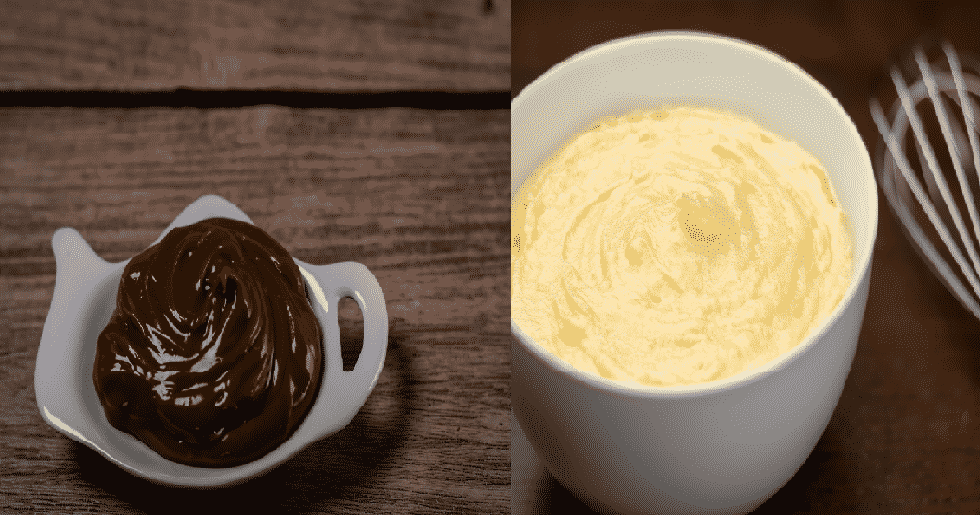
Puddings and creams have earned a favorite spot in our dessert menus because of their sweet and creamy flavors. However, pastry cream vs. pudding has always been a matter of debate because people end up confusing these classic desserts. So, with this article, we are settling the confusion, so you know what’s what!
Pastry Cream vs Pudding
Pudding
Whenever we want to eat something sweet, nothing seems more delicious than a cup of pudding because of the luscious and creamy texture. Given this demand, various supermarkets have started offering instant puddings, which are made with cold milk. These instant puddings are delicious and convenient, but the real flavor comes from the pudding that’s cooked in an old-fashioned style (who remembers their grandma’s pudding?).
So, the classic pudding is made with a cream-based or sweetened milk mixture which is often thickened with starch (gelatinized starch, to be precise). For the most part, flour or cornstarch is used to thicken up the texture and is cooked in a pan. Pudding is extremely versatile and can be mixed up with trifles as well. As far as the flavor is concerned, the traditional pudding is only available in vanilla flavor, but people also make pumpkin, chocolate, and mochaccino flavors.
Pudding is famous for its thick, soft, and spongy texture and is extremely popular in the United States. It is made with milk which is thickened with flour or cornstarch, and it’s flavored with eggs, bread, rice, and other fruit juices. It wouldn’t be wrong to say that puddings are thickened soufflé or custards. On the other hand, the British people only know pudding as a dessert that’s made with leavened batter, and it’s mixed with fresh fruits or dried fruits to enhance the flavor.
On top of everything, pudding has a rich flavor, and this dairy-based dessert has become everyone’s ultimate favorite. Also, many people tend to confuse pudding with custard, but these two are completely different desserts. Pudding can be mixed with steamed cakes to make sponge pudding, which can be topped with dried fruits as well. All in all, pudding is sensitive to make because you’ve to keep stirring because if it sticks to the pan’s bottom, the flavor will be ruined (burnt flavor).
Pastry Cream
Pastry cream is not a dessert because it’s widely popular as a filling. It has become an ultimate staple in pastry restaurants and pastry kitchens. Pastry cream is widely used for filling napoleons, cakes, and tarts. For the most part, it’s used in vanilla flavor, but pastry experts have started making it in chocolate, lemon, and lime flavors. As for vanilla-flavored pastry cream, pure vanilla extract is used because the artificial flavorings add bitter taste profiles.
To define, pastry cream is basically custard thickened with starch and has higher stability as compared to custards and puddings. In addition, pastry cream is low likely to curdle. Some people also make pastry cream with gelatin since it creates a firmer and denser texture while adding structure (the texture is so firm that it can be sliced). Pastry cream is used for filling, as we have already mentioned, but it’s always used in the cold form and cannot be eaten on its own.
The original flavor of pastry cream is pretty mild because it’s all milk, eggs, and starch which makes it easy to add flavorings. Also, vanilla is the classic flavor because it has to complete other flavors of the dessert (it’s used as a filling). In addition, some alcoholic desserts use pastry cream mixed with rum. As far as making is concerned, it’s made by heating sugar, starch, milk, eggs, and flavoring to make the thick, creamy, and rich consistency.
Pastry cream is generally filled into the pipes and used for filling the desserts and cream puffs. It’s a great option for fruit tarts if you want a base. Not to forget, it can be spread between different layers of cream pies to add rich flavor. At this point, we do want to tell you that flavoring the pastry cream is a serious matter because everything needs to be mixed thoroughly. For this purpose, you can infuse flavors by mixing them with milk, using wet stir-ins, pastes, and dry stir-ins.